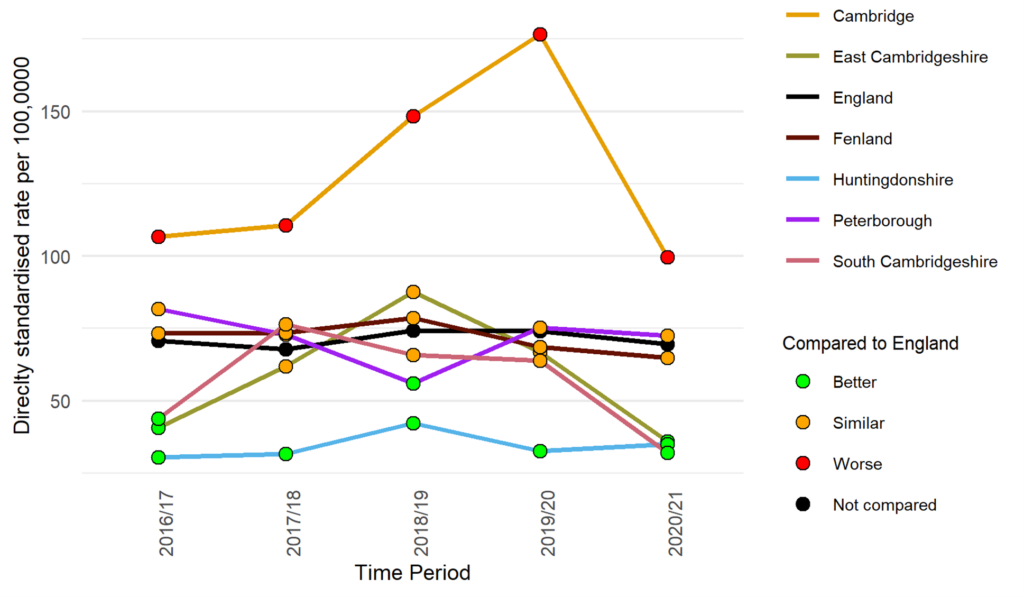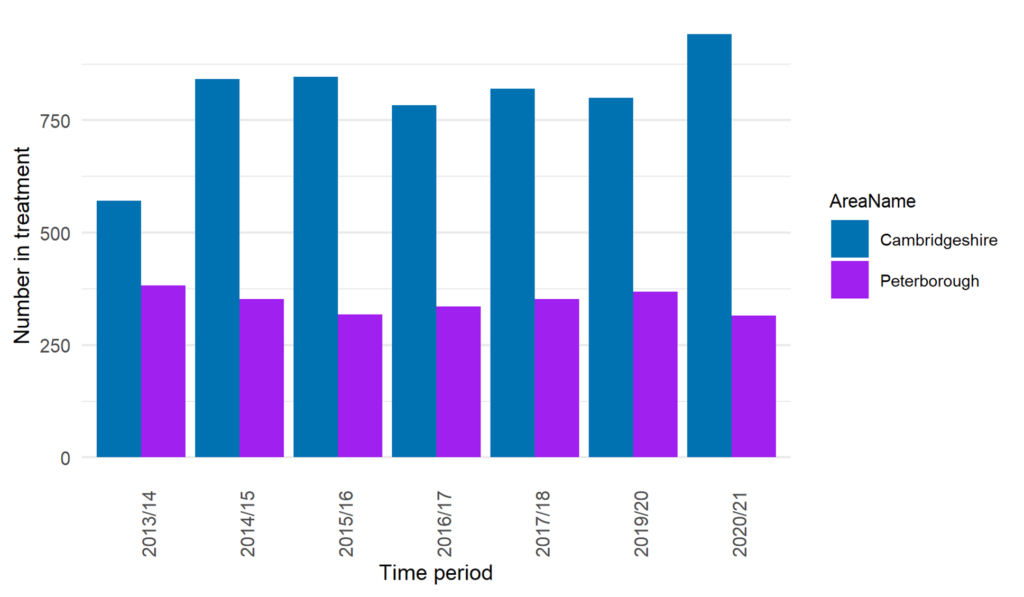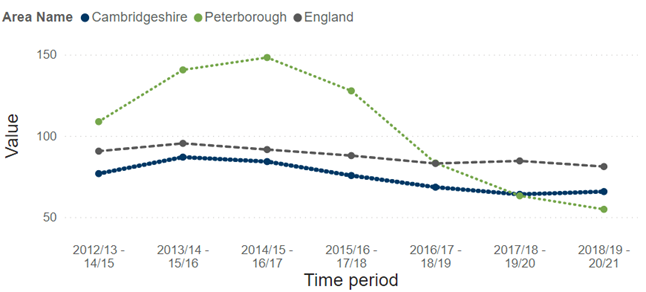Alcohol use
- Alcohol use is the third leading preventable cause of ill health and the top cause of poor health and disability in people aged between 15 to 49 years (Institute for Health Metrics and Evaluation, 2022).
- People with poor mental health are more likely to consume harmful levels of alcohol:
- Children and young people who a mental health condition are several times more likely to consume alcohol than their peers, a large proportion of whom begin before adulthood (Campion, 2019).
- Having anxiety or depression as a teenager increases the risk of harmful alcohol use as an adult (Campion, 2019).
- There are common risk factors for both harmful alcohol use and mental health conditions:
- For example, experiencing 4+ adverse childhood experiences is associated with over 4 times the risk of having depression and twice the risk of heavy alcohol use (Campion, 2019).
- Alcohol-related harms (deaths and hospitalisations) disproportionately impact people from the most deprived neighbourhoods (L. Jones et al., 2015).
- Harmful levels of alcohol use are likely to impact mental health:
- Harmful alcohol use doubles the risk of developing major depression and is associated with over twice the risk of death by suicide (Campion, 2019).
- Self-medication of mental health symptoms with alcohol can lead to a cycle of escalating alcohol use and increasingly poor mental health (Public Health England, 2019a).
- Drinking above guideline amounts is linked to issues such as unemployment, domestic abuse and homelessness (Public Health England, 2018a). This can compound poor mental health,
- For example, 39% of violent crimes are thought to be carried out by perpetrators under the influence of alcohol (Richards, 2020)
What is the local picture?
- Cambridgeshire has above average rates of unsafe alcohol consumption (Elvin et al., 2023):
- It has been estimated that a greater proportion of adults in Cambridgeshire drink over 14 units of alcohol a week (28.7%) than the national average (22.8%).
- A higher proportion than average of adult binge drink on their heaviest drinking day (17.7%), compared to the national average (15.4%).
- Similarly, Peterborough has above average rates of unsafe alcohol consumption (Elvin et al., 2023).
- It has been estimated that a greater proportion of adults in Peterborough drink over 14 units of alcohol a week (24.9%) than the national average (22.8%).
- Alcohol-related hospital admissions for mental and behavioural disorders have been significantly higher in Cambridge than the national rate since 2016/17, for both narrow and broad definitions of alcohol-related admissions. The rate of hospital admissions in all other areas across Cambridgeshire and Peterborough have been significantly lower or statistically similar to the national rates (Office for Health Improvement and Disparities, 2022a).
- Admissions related to alcohol can be defined broadly (including primary or secondary diagnosis of alcohol-attributable mental and behavioural disorders) or narrowly (only counting primary diagnosis of alcohol-attributable mental and behavioural disorders)

Figure 110: Admission episodes for mental and behavioural disorders due to use of alcohol (Broad). Data source: (Office for Health Improvement and Disparities, 2022a)

Figure 111: Admission episodes for mental and behavioural disorders due to use of alcohol (Narrow). Data source: (Office for Health Improvement and Disparities, 2022a)
The rate of hospital admissions for intentional self-poisoning increased in 2020/21 compared to the previous year in Peterborough, Fenland and Huntingdonshire; in which admission rates were significantly higher than the national rate (Office for Health Improvement and Disparities, 2023).
- The hospital rate of admissions in Cambridge has shown a steep decline since 2016/17; and there has also been a decline in rates in East and South Cambridgeshire since 2017/18.

Figure 112: Hospital admission episodes for intentional self-poisoning by and exposure to alcohol (where the primary diagnosis is an alcohol-related condition). Data source: (Office for Health Improvement and Disparities, 2023)
Substance use in young adults
There were 185 hospital admissions due to substance use in young people (aged 15 to 24) in 20118/19 to 20/21. Hospital admissions due to substance use are below the national average in both Cambridgeshire and Peterborough.
Figure 113: Hospital admissions due to substance use in 15- to 24-year-olds per 100,000 of the population, 2008/9 – 2020/21. Data source: Fingertips
Treatment
- Estimates suggest that there are 5,775 adults in Cambridgeshire and 2,284 adults in Peterborough in need of alcohol treatment (Elvin et al., 2023). However, there remains 4,505 people in Cambridgeshire and 1,796 people in Peterborough who are not currently in treatment.
- This is a similar proportion of people in who are dependent on alcohol who are not currently in treatment in Cambridgeshire (78%) and Peterborough (79%) to the national average (78%) (147).

Figure 114: Proportion of dependent drinkers not in treatment. Data sources: (Office for Health Improvement and Disparities, 2023)
There are increasing numbers of people in alcohol use services across Cambridgeshire and Peterborough (Office for Health Improvement and Disparities, 2022a):
- 942 people accessed services in Cambridgeshire in 2020/21 compared to 800 in the previous year.
- However, there was a slight decrease in Peterborough, with 315 people accessing treatment in 2020/21 compared to 368 in 2019/20.

Figure 115: Numbers of people in treatment at specialist alcohol use services in Cambridgeshire and Peterborough. Data source: (Office for Health Improvement and Disparities, 2022a)
Additional resources
- The local data pack gives an overview of key data and trends
- Cambridgeshire and Peterborough Drug and Alcohol Needs Assessment 2023
- Cambridgeshire and Peterborough-Drugs and Alcohol Priorities (2022-2027)
- Cambridgeshire insight has information about local alcohol use
- The experiences of local service users, told in their own words
- Practice standards for young people with substance misuse problems
- Alcohol use in people aged 65 and over in Southwark – example case study
References
Full list of references is included at the end of this chapter.

